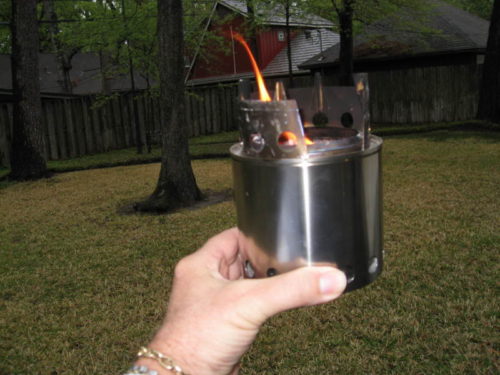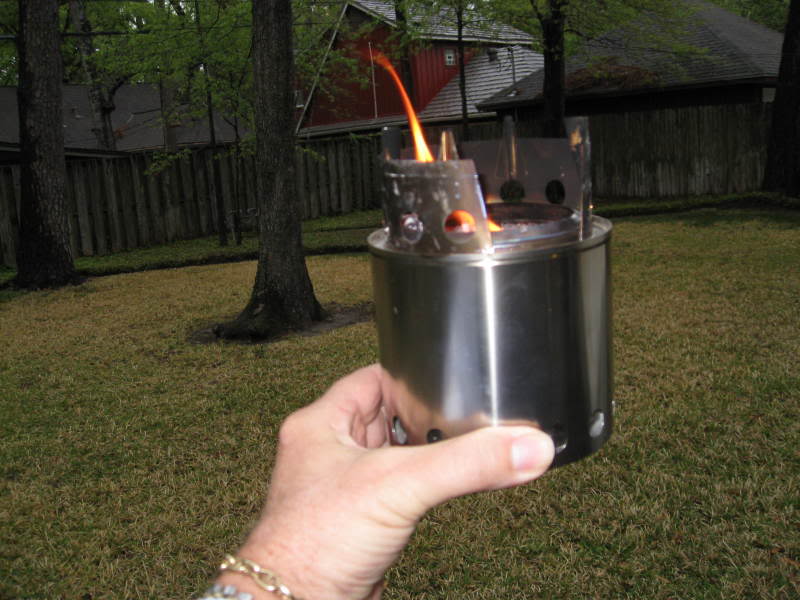
The original wood burning double walled secondary combustion wood gasifier stove. We have owned the ‘Ultra’ (145 gram) model of this stove for many years and have used it innumerable times. Apart from some expected blackening it shows no sign of wear and still works perfectly. We use the stove on longer trips (to save fuel) and where open fires are prohibited such as some National Parks. As you can see from the picture the stove will not generate enough heat at the bottom to scorch the ground or ignite anything there. I was given the lighter Suluk alternative as a present, so I usually carry it now. Even in relatively treeless areas (or very wet areas) you can usually find enough dry twigs to light such as stove and boil the billy.
Of course my egg Ring stove http://www.theultralighthiker.com/the-egg-ring-ultralight-wood-burner-stove/ is much lighter, but it will scorch the ground. I personally do not see this as a problem: over the years I have observed that there are many plants which have clearly evolved to grow after such small fires (not surprising when one considers the long prehistory of human habitation of the Australian continent. Indeed I have observed that there are plants which rapidly colonise an old campfire site which grown nowhere else!
The Bushbuddy was originally invented by Fritz Handel of http://bushbuddy.ca/indexs.html & now made by his apprentice Jeff Tinker (sic!) of: http://www.nomadicstovecompany.com/#!/our-story/ A Titanium version (86 grams) is manufactured by: http://www.suluk46.com/products%20%20-%20P14%20TDW%20Stove.html
‘About the BUSHBUDDY
Like the Bushbuddy Ultra, this stove was designed to provide the cooking needs of one or two people, but can also serve the needs of a family or small group if two stoves are carried.
It weighs just 5 1/2 oz, and makes a compact package 4 1/4″ in diameter and 3 3/4″ high when nested (the same size as the Bushbuddy Ultra), which will fit inside the Snow Peak Trek 900 titanium pot, and many other pots of similar or larger capacity. It’s compact size and light weight make it ideally suited to the needs of the backpacker, cyclist, and other outdoor travelers. Because it burns wood, it is a very economical stove to use.
There is also no need to carry your fuel with you wherever wood is available (it does not need batteries), making it useful for long trips, or when traveling in remote areas of the world where liquid fuels may not be available. It is aircraft friendly too.
Under good conditions (protected from wind and rain and with a lid on the pot) the BUSHBUDDY can boil one quart of water in about 8-10 minutes. It is a very efficient stove, consuming only about 14 oz. of wood per hour at maximum heat, less at lower heat.
Because of its unique design which uses a double wall around the firebox to preheat secondary combustion air, you will find that you can burn wood as cleanly as a candle.
Just be sure to use dry wood only, and add it at regular intervals to
maintain an open flame.
The BUSHBUDDY is made of high quality 18% chrome 8% nickel stainless steel for many years of trouble free use. The grate is made of nichrome wire, as in the Bushbuddy Ultra, for the longest possible life.
THE BUSHBUDDY ULTRA NOW AVAILABLE
First custom made for Ryan Jordan of Backpackinglight magazine, for his Arctic 1000 trek in June of 2006, this stove features the same efficient combustion design as the regular Bushbuddy, but in a lighter weight (5 ounces, instead of 6.5 ounces for the regular model). The two stoves are identical in size.
Specs are:
Can boil 1 liter of water in 8-10 minutes
(will take longer under adverse conditions)
Weight 5.1 ounces
Size 4 1/4″ diameter by 3 3/4″ high
For compact storage, this stove is designed to nest inside the Snow Peak Trek 900 (.9L) titanium pot, but will also fit inside many other pots of similar or larger capacity. (Because of the light weight construction of this stove, it is essential to protect it by storing it in your cookpot.).
To assemble : Place the stove on the ground with the ring of holes at ground level; remove
the upper section of the stove from within the firebox, invert it and place
it on top of the stove.
Where to set up : The stove will not perform well in windy conditions. It is very important to set the stove up in a sheltered area or to create a windbreak. Any time spent in searching for or creating shelter will be more than repaid in time saved waiting for water to boil.
The BUSHBUDDY can be safely placed directly on a wooden surface such as an outdoor picnic table, and it will not scorch it in normal use. If you set up the stove on the ground, clear the surrounding area of flammable materials like grass or leaves, because the fire sometimes tosses out sparks. The stove can be picked up and moved to a new location while burning if you are careful to hold only the lower base section. (In hot weather you may need to use gloves or pot holders.)
Do not use the stove indoors unless you have a means of venting the exhaust gases to the outdoors, such as a teepee with a vent at the top.
To start a fire : Use only dry wood. When other fire starting materials are not available, make three or four short fuzz sticks with your knife. Also collect a handful of small dry twigs or split some fine kindling. Light one of the fuzz sticks and place it in the firebox so the flames will climb up the shavings. Add a second fuzz stick, and as the fire grows, some of the fine kindling. If the fire begins to die down, add a third fuzz stick, and then some more kindling. Once the fire is burning well, you can begin adding bigger pieces of wood. The chief cause of difficulty in starting a fire is using wood that is not really dry; in particular avoid using stuff found lying on the ground to start a fire, even if it seems dry.?
Although the stove can be fed with nothing more than twigs broken up by hand, bigger solid pieces of wood will be found much more satisfactory, burning longer with less feeding of the fire. An easy way to cut the short pieces of wood needed is to place the wood over a log and nick each side with an ax, then hit the end with the poll of the ax to break it off. Or, a small saw such as the on a Leatherman tool or Swiss Army Knife can be used to nick each side of the wood lightly, so that it can be easily broken to length. This saves the effort of sawing right through. With an ax, however, larger diameter pieces of wood (such as a small dead tree) can be utilized too, by first splitting and then breaking into shorter pieces. (Lean any leftover wood against a tree to keep it dry for future use by yourself or others.) Twigs, chips, roots, bark, and pine cones all make good fuel once the fire is going well, if they are reasonably dry. Under rainy conditions anything lying on the ground is sure to be too damp. The driest wood available is often the lower dead branches of living trees, particularly conifers such as spruce which shelter their lower branches. If in doubt about the availability of good dry wood at the campsite, collect some along the trail when the opportunity arises, and take it with you.
Cooking : A frying pan or pot can be placed directly on the stove, and wood can be fed to the fire through the opening in the upper section without removing the pot. With a little experience, the heat can be controlled to some extent by regulating the amount of fuel added to the fire. For example, to simmer a pot of rice once it has boiled, add only one medium sized piece of wood at a time and then only just when the flames are about to go out. (If the flames do go out, add a small chip of wood only, and wait for the flames to re-ignite and raise the firebox temperature, before adding more wood.)
For longer or more gentle simmering, it is better to suspend the pot a little above the stove. One of the simplest ways to do this is by using the traditional dingle stick (a stick jammed into the ground at an angle, with a rock or log placed in the angle formed with the ground). The pot is hung on the end of the stick, and can be raised or lowered by adjusting the position of the supporting rock or log. Suspending the pot has other advantages too, among them a reduced likelihood of accidentally spilling it, (especially if the ground is not firm), and a cleaner burning fire with easier feeding. If you have a very large pot or bucket to heat, two stoves can be placed under a suspended pot.
To sterilize water : If you are unsure of the safety of your water supply, bringing it to a rolling boil will kill any microorganisms–no need for prolonged boiling. Boiling will not protect you from chemical contamination.
Using the BUSHBUDDY as a campfire : In moderate weather, the stove makes a great alternative to an open campfire, providing light, warmth and cheer while conserving firewood.
Safety : Use the stove where open campfires are permitted. The stove can toss out sparks (due to tiny steam explosions of slightly damp wood), something that a liquid fueled stove does not do. Set the stove up in an area cleared of combustible materials like leaves and grass, and watch for any sparks tossed out. Before leaving your campsite, dump any remaining charcoal on bare earth and thoroughly drench it with water.’

